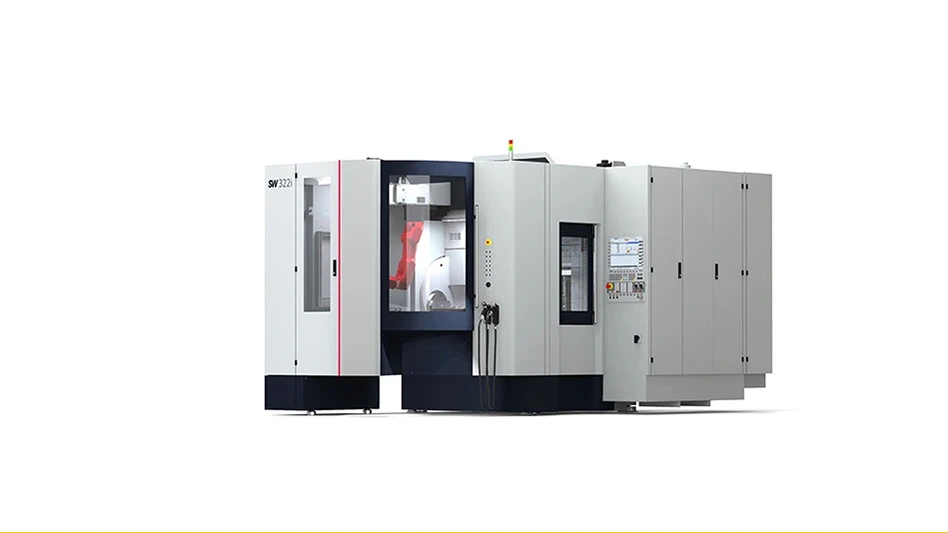

Traditionally, Bumotec has been inextricably linked to the world of watchmaking. From an outsider perspective, this universe has its own set of laws and specific needs that are far away from general mechanical engineering. This is not just due to the size of the parts that make up a watch, but also their complex geometries, which make clamping the workpieces difficult. Added to this are the requirements for accuracy, surface quality, cycle times, and the precious and increasingly unusual materials machined. All of this requires the use of highly specialized machinery in a very special area that at first glance bears little resemblance to other areas of the industry. However, some commonalities have emerged from the parts portfolio approach that Bumotec has adopted for several years, which have led to the development of more versatile machines also meeting the needs of other industrial sectors, such as medical technology.

Guy Ballif, head of the luxury goods market, and Damien Chêne, head of the medtech market, talk about the developments in these very specific markets and offer an outlook for the future.
“The luxury goods industry is an important sector for Bumotec. Between 1985 and 1990, the focus was mainly on watches. Both our history and our success received a powerful boost with the arrival of the steel bracelet produced from bars. We had developed the S94 for this purpose in the 1990s, which later gave rise to other models that have since become flagships, such as the Bumotec S1000 and the transfer machines. This further development of our machines was influenced by the development of the luxury market and took place throughout 20 years – and is still continuing. Then came the complex watch mechanisms that required even more precise machines. Since 2005, the use of hard materials such as carbide, ceramics, or even more unusual materials such as carbon has meant our machines have had to evolve to meet the new demands of our customers.

“Our customers’ requirements are becoming increasingly focused on higher quality surface finishes, and they want to be able to produce finished parts on the machine without any post-processing. This requires reliable machines for continuous production, although these are more complex and prone to malfunctions. We put a lot of work into the reliability of our machines, for example with predictive maintenance and support for our customers,” Ballif says.
“Our involvement in the medtech sector has evolved with the materials. From the moment watchmakers switched to stainless steel and then to medical stainless steel, we were able to acquire extensive knowledge about the specifics of working with these materials. To further expand this knowledge, we also turned our focus to new markets such as medtech, aerospace, and micromechanics. By further developing the machines, especially in terms of the main and back-working spindle, we were able to offer machines that are suitable for the medical sector,” Chêne explains.
“We later established branches in the U.S., our biggest market, but also in Asia, France, and Germany. We’ve even supplied transfer machines, particularly for orthodontic production. But medical technology is a very specific field with many administrative and traceability requirements. It’s a very demanding market that isn’t profitable without volume. The acquisition of Bumotec by the Starrag Group gave us the opportunity to further expand this area through the group’s subsidiaries abroad. Our major strength is we can offer our customers a turnkey solution. In this complex field, partnership with our customers is crucial, as developments are made together. Significant success is only possible with true collaboration.”
Innovative solutions
Jérôme Zbinden, head of research and development at Starrag Vuadens, explains the most important trends that have been decisive factors in these new developments.

“Several points were particularly important in developing the Bumotec machines. The first is inextricably linked to the increasing complexity of the parts that our customers are machining. Modern machine tools and their ability to control multiple axes simultaneously have swept away the last constraints on creativity and complex geometries. The extreme complexity of the parts our customers produce meant the operation of our machines also became increasingly complex. This brings us to the second point: developing the most user-friendly human-machine interface (HMI) possible to make the user’s work as easy as possible. By switching to a PC-based control system, which still comes from FANUC, we were able to realize this. The third point concerns the type of materials our customers process. Use of difficult-to-machine, hard, or even unusual materials has driven us to implement solutions that can process these materials. The fourth point concerns the required footprint of our machines, which is becoming smaller and smaller. And the last point concerns the environment and energy – more economical machines. Based on these points, we have implemented various technological solutions to offer increasingly efficient machines.
“The constant development of design and simulation software has been a great help to us, and CAM has enabled us to use our machines to their limits. The transition to high-speed cutting (HSC) in the 1990s required much greater dynamics in the machines. This puts much more strain on their basic functions. We’ve been using linear motors in our machines for a long time. Their use brings many advantages, starting with very high dynamics, but also increased rigidity due to the magnetic pull of the motor. Eliminating the recirculating ball screw means there are no more problems caused by wear and thermal regulation is easier, as only the motor needs to be cooled. The increasing number of sensors and processing their data in real time already enable us to proactively prevent any risk of machine downtime due to tool breakage or excessive wear, a full chip container, empty bar feeder, or low oil level. Today, we are striving to further minimize the risks associated with the wear of certain machine components with artificial intelligence (AI), machine learning (ML), and other tools enabling us to develop predictive maintenance with increasing reliability.”
Swiss reliability
Today, Bumotec machines are used by industrial companies from a range of sectors. The Bumotec product line offers a comprehensive selection. From 3-axis machining centers to transfer machines, and machines for diamond cutting and faceting to combined milling and turning machines, Starrag’s range covers a broad spectrum. A customized machine that meets very specific expectations, the machines have hand-scraped surfaces for maximum precision, and the linear motors, a technology that has been used for almost 20 years, provide the necessary dynamics. But a Bumotec is above all a machine that can fully machine components without needing to rework them at another station. Machining from bar stock, back-working spindle, high-level automation – everything is in place to enable these machines to produce around the clock with Swiss reliability.
Starrag
https://www.starrag.com

Explore the January/Februrary 2024 Issue
Check out more from this issue and find your next story to read.
Latest from Today's Medical Developments
- Tariffs threaten small business growth, increase costs across industries
- Feed your brain on your lunch break at our upcoming Lunch + Learn!
- Robotics action plan for Europe
- Maximize your First Article Inspection efficiency and accuracy
- UPM Additive rebrands to UPM Advanced
- Master Bond’s LED415DC90Med dual-curable adhesive
- Minalex celebrates 60 years of excellence in miniature aluminum extrusions
- Tormach’s Chip Conveyor Kit for the 1500MX CNC Mill





